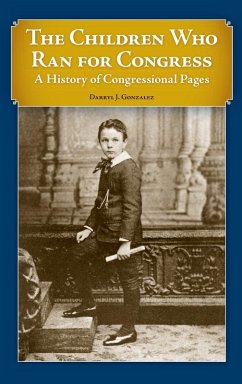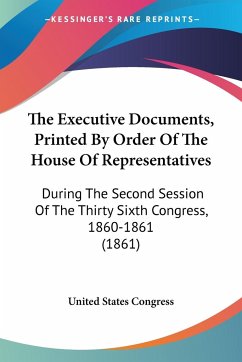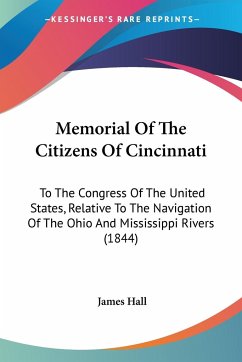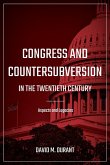- Gebundenes Buch
- Merkliste
- Auf die Merkliste
- Bewerten Bewerten
- Teilen
- Produkt teilen
- Produkterinnerung
- Produkterinnerung
This book offers a meticulously researched, comprehensive chronology of the Congressional Page system, from the late 1700s to modern day. From the origins of the page system in 1774 to the period in the 1940s when Congress demonstrated an indifference towards the needs of providing the boys with supervised living arrangements, congressional pages have a storied past. It's a topic that can be amusing-for years, pages simply treated the Capitol as a their private playground to subject adults to their mischief-and sobering, as Congress continued to employ boys as young as eight years old, even…mehr
Andere Kunden interessierten sich auch für
![The Executive Documents, Printed By Order Of The House Of Representatives The Executive Documents, Printed By Order Of The House Of Representatives]() United States CongressThe Executive Documents, Printed By Order Of The House Of Representatives44,99 €
United States CongressThe Executive Documents, Printed By Order Of The House Of Representatives44,99 €![Theodore Roosevelt An Address Delivered by Henry Cabot Lodge Before the Congress of the United States Theodore Roosevelt An Address Delivered by Henry Cabot Lodge Before the Congress of the United States]() Henry Cabot LodgeTheodore Roosevelt An Address Delivered by Henry Cabot Lodge Before the Congress of the United States19,99 €
Henry Cabot LodgeTheodore Roosevelt An Address Delivered by Henry Cabot Lodge Before the Congress of the United States19,99 €![Memorial Of The Citizens Of Cincinnati Memorial Of The Citizens Of Cincinnati]() James HallMemorial Of The Citizens Of Cincinnati20,99 €
James HallMemorial Of The Citizens Of Cincinnati20,99 €![A Letter to the Hon. Samuel Eliot, Representative in Congress From the City of Boston, In Reply to His Apology For Voting For the Fugitive Slave Bill. A Letter to the Hon. Samuel Eliot, Representative in Congress From the City of Boston, In Reply to His Apology For Voting For the Fugitive Slave Bill.]() HancockA Letter to the Hon. Samuel Eliot, Representative in Congress From the City of Boston, In Reply to His Apology For Voting For the Fugitive Slave Bill.17,99 €
HancockA Letter to the Hon. Samuel Eliot, Representative in Congress From the City of Boston, In Reply to His Apology For Voting For the Fugitive Slave Bill.17,99 €![Congress and Countersubversion in the 20th Century Congress and Countersubversion in the 20th Century]() David M. DurantCongress and Countersubversion in the 20th Century25,99 €
David M. DurantCongress and Countersubversion in the 20th Century25,99 €![A Check List Of American Eighteenth Century Newspapers In The Library Of Congress (1912) A Check List Of American Eighteenth Century Newspapers In The Library Of Congress (1912)]() A Check List Of American Eighteenth Century Newspapers In The Library Of Congress (1912)28,99 €
A Check List Of American Eighteenth Century Newspapers In The Library Of Congress (1912)28,99 €![The Trump-Ukraine Impeachment Inquiry Report The Trump-Ukraine Impeachment Inquiry Report]() House Intelligence CommitteeThe Trump-Ukraine Impeachment Inquiry Report19,99 €
House Intelligence CommitteeThe Trump-Ukraine Impeachment Inquiry Report19,99 €-
-
-
This book offers a meticulously researched, comprehensive chronology of the Congressional Page system, from the late 1700s to modern day. From the origins of the page system in 1774 to the period in the 1940s when Congress demonstrated an indifference towards the needs of providing the boys with supervised living arrangements, congressional pages have a storied past. It's a topic that can be amusing-for years, pages simply treated the Capitol as a their private playground to subject adults to their mischief-and sobering, as Congress continued to employ boys as young as eight years old, even after passing labor laws that prohibited it and was reluctant to provide supervised living arrangements for decades. Unlike many dry and lifeless books about Congressional history, The Children Who Ran For Congress: A History of Congressional Pages provides a lively and engaging look at the history of the page system, a topic that has largely been ignored. Based on a thorough investigation of historical documents and personal interviews, Darryl Gonzalez now tells the complete story of the young boys (and girls) who have served Congress for more than 200 years.
Hinweis: Dieser Artikel kann nur an eine deutsche Lieferadresse ausgeliefert werden.
Hinweis: Dieser Artikel kann nur an eine deutsche Lieferadresse ausgeliefert werden.
Produktdetails
- Produktdetails
- Verlag: Praeger
- Seitenzahl: 328
- Erscheinungstermin: 21. Oktober 2010
- Englisch
- Abmessung: 240mm x 161mm x 22mm
- Gewicht: 658g
- ISBN-13: 9780313386664
- ISBN-10: 0313386668
- Artikelnr.: 29504410
- Herstellerkennzeichnung
- Libri GmbH
- Europaallee 1
- 36244 Bad Hersfeld
- gpsr@libri.de
- Verlag: Praeger
- Seitenzahl: 328
- Erscheinungstermin: 21. Oktober 2010
- Englisch
- Abmessung: 240mm x 161mm x 22mm
- Gewicht: 658g
- ISBN-13: 9780313386664
- ISBN-10: 0313386668
- Artikelnr.: 29504410
- Herstellerkennzeichnung
- Libri GmbH
- Europaallee 1
- 36244 Bad Hersfeld
- gpsr@libri.de
Darryl J. Gonzalez, PhD, is a federal employee in Washington, DC, and has worked in education for 20 years.
Acknowledgments Chapter One Overview Introduction Part One: The Written
Records Part Two: Data Gathering Interviews Chapter Two The Ancestors of
Today's Pages, 1774 to 1926 Introduction Part One: America's Founding
Fathers, and Her Founding Boys Congressional Messengers before 1800 The
First Senate Pages The First House Pages and the First Supreme Court Page
Part Two: Who Pages Were Using Young Boys as Pages Becoming a Page
Appointing Orphans as Pages Special Pages Part Three: The Unique Community
of Pages Pages and Their Relationships with Members Page Mischief Part
Four: The Attention Paid to Formal Schooling Chapter Three Congress
Passively Delegates Control of Capitol Page School to Private Individuals,
1926 to 1942 Introduction Part One: Child Advocacy Laws Put Pressure on
Congress Child Labor in the District of Columbia Compulsory Education in
the District of Columbia Part Two: The Page System Adds a School, 1926 to
1931 Parents Hire a Private Tutor, 1926 Laupheimer and Butler Collaborate
to Form a Page School, 1927 to 1929 Devitt Assumes Control of Capitol Page
School, 1929 to 1931 Part Three: Another Chance Meeting Leads to Another
Page School, 1931 to 1942 Kendall and McClintic Collaborate to Form a Page
School, 1931 Kendall's Capitol Page School Grows, 1932 to 1942 Part Four:
Kendall and the Roosevelt White House Part Five: Pages in the News, 1939 to
1940 Chapter Four Senator Burton Advocates for Pages, 1942 to 1949
Introduction Part One: Burton Visits Page School and Effects Change Part
Two: Burton's Involvement Continues, 1942 to 1943 Part Three: The Little
Congress and Alice Tuohy Part Four: The House Committee on Public Buildings
and Grounds, October 1943 Part Five: Fallout from Tuohy's Letter, December
1943 to the Summer of 1944 Part Six: Setbacks for Kendall, 1944-1945 School
Year Introduction President Roosevelt Dies; Truman Abandons Diplomatic
School, April 1945 Anderson Attacks Kendall and Page School, May 1945
Congressional Hearings to Investigate Page School, June 1945 Part Seven:
Pages Secure a Residence, and the 1945-1946 School Year Part Eight: Page
School Goes from Private Control to Public, and the 1946-1947 School Year
Part Nine: Capitol Page School Operates under Public Control, 1947-1949
The 1947-1948 School Year The 1948-1949 School Year Chapter Five Attempts
at Change and Institutional Inertia, 1949 to 1982 Introduction Part One:
Page School Outgrows Its Space in the Capitol Page School Moves Up in the
World, from Basement to Attic, 1949 Plans to Move Page School to the New
Senate Office Building, 1949 to 1958 Part Two: A Page Residence and More
Inertia, 1951 to 1963 Review of Legislation, 1951 to 1956 Early Attempts at
Change, 1956 The Change Effort Gains Momentum, 1956-1957 School Year
Efforts to Secure Housing Continue, 1959 to 1963 A Congressional Hearing
and the Washington Post Series, 1963 Part Three: Edith Green Gives the
Change Movement New Focus, 1964 to 1965 Green's Committee Chinks Away at
Institutional Inertia, 1964 Green Fights for Change Again, 1964 to 1965
The Aftereffects of Green's Advocacy, 1965 Part Four: Continued Attempts at
Change, 1966 to 1982 The Period of Policy Churn Continues, 1966 to 1970
The Period of Inertia Continues, 1970 to 1975 Focus Turns to Page School,
1976 to 1978 Part Five: Key Players Look Back and Comment on the Page
System Part Six: Pages in the News, 1957 Part Seven: Accreditation at a
Boarding School with No Boarding Facilities, 1949 to 1974 Chapter Six
Marginalized Groups within the Page System Introduction Part One: African
American Pages, 1954 to 1965 Part Two: Congress Wrestles with Allowing
Female Pages, 1917 to 1971 The "First" Female Page, 1939 Girls Test the
Page System, 1939 to 1954 Senators Javits and Percy Force the Issue, 1970
to 1971 Part Three: Supreme Court Pages Chapter Seven Capitol Page School
Is Closed, 1982 to 1983 Introduction Part One: Pages Embarrass Congress
with Accusations, June 1982 Part Two: The Task Force Recommends Changes
Part Three: Senate Page School Remains a Public-Private School under DCBOE
and House Page School Becomes an Independent School Part Four: Robert
Knautz Founds the New House Page School Part Five: House Page School Opens,
September 1983 Postscript Chapter Eight Discussion Part One: Changes and
Inertia at Page School Part Two: Changes and Inertia Concerning a Residence
Part Three: Changes and Inertia in Admitting Minorities Part Four:
Conclusion and Remaining Questions Appendix 1: Timeline Appendix 2: List of
Interviews Notes Index
Records Part Two: Data Gathering Interviews Chapter Two The Ancestors of
Today's Pages, 1774 to 1926 Introduction Part One: America's Founding
Fathers, and Her Founding Boys Congressional Messengers before 1800 The
First Senate Pages The First House Pages and the First Supreme Court Page
Part Two: Who Pages Were Using Young Boys as Pages Becoming a Page
Appointing Orphans as Pages Special Pages Part Three: The Unique Community
of Pages Pages and Their Relationships with Members Page Mischief Part
Four: The Attention Paid to Formal Schooling Chapter Three Congress
Passively Delegates Control of Capitol Page School to Private Individuals,
1926 to 1942 Introduction Part One: Child Advocacy Laws Put Pressure on
Congress Child Labor in the District of Columbia Compulsory Education in
the District of Columbia Part Two: The Page System Adds a School, 1926 to
1931 Parents Hire a Private Tutor, 1926 Laupheimer and Butler Collaborate
to Form a Page School, 1927 to 1929 Devitt Assumes Control of Capitol Page
School, 1929 to 1931 Part Three: Another Chance Meeting Leads to Another
Page School, 1931 to 1942 Kendall and McClintic Collaborate to Form a Page
School, 1931 Kendall's Capitol Page School Grows, 1932 to 1942 Part Four:
Kendall and the Roosevelt White House Part Five: Pages in the News, 1939 to
1940 Chapter Four Senator Burton Advocates for Pages, 1942 to 1949
Introduction Part One: Burton Visits Page School and Effects Change Part
Two: Burton's Involvement Continues, 1942 to 1943 Part Three: The Little
Congress and Alice Tuohy Part Four: The House Committee on Public Buildings
and Grounds, October 1943 Part Five: Fallout from Tuohy's Letter, December
1943 to the Summer of 1944 Part Six: Setbacks for Kendall, 1944-1945 School
Year Introduction President Roosevelt Dies; Truman Abandons Diplomatic
School, April 1945 Anderson Attacks Kendall and Page School, May 1945
Congressional Hearings to Investigate Page School, June 1945 Part Seven:
Pages Secure a Residence, and the 1945-1946 School Year Part Eight: Page
School Goes from Private Control to Public, and the 1946-1947 School Year
Part Nine: Capitol Page School Operates under Public Control, 1947-1949
The 1947-1948 School Year The 1948-1949 School Year Chapter Five Attempts
at Change and Institutional Inertia, 1949 to 1982 Introduction Part One:
Page School Outgrows Its Space in the Capitol Page School Moves Up in the
World, from Basement to Attic, 1949 Plans to Move Page School to the New
Senate Office Building, 1949 to 1958 Part Two: A Page Residence and More
Inertia, 1951 to 1963 Review of Legislation, 1951 to 1956 Early Attempts at
Change, 1956 The Change Effort Gains Momentum, 1956-1957 School Year
Efforts to Secure Housing Continue, 1959 to 1963 A Congressional Hearing
and the Washington Post Series, 1963 Part Three: Edith Green Gives the
Change Movement New Focus, 1964 to 1965 Green's Committee Chinks Away at
Institutional Inertia, 1964 Green Fights for Change Again, 1964 to 1965
The Aftereffects of Green's Advocacy, 1965 Part Four: Continued Attempts at
Change, 1966 to 1982 The Period of Policy Churn Continues, 1966 to 1970
The Period of Inertia Continues, 1970 to 1975 Focus Turns to Page School,
1976 to 1978 Part Five: Key Players Look Back and Comment on the Page
System Part Six: Pages in the News, 1957 Part Seven: Accreditation at a
Boarding School with No Boarding Facilities, 1949 to 1974 Chapter Six
Marginalized Groups within the Page System Introduction Part One: African
American Pages, 1954 to 1965 Part Two: Congress Wrestles with Allowing
Female Pages, 1917 to 1971 The "First" Female Page, 1939 Girls Test the
Page System, 1939 to 1954 Senators Javits and Percy Force the Issue, 1970
to 1971 Part Three: Supreme Court Pages Chapter Seven Capitol Page School
Is Closed, 1982 to 1983 Introduction Part One: Pages Embarrass Congress
with Accusations, June 1982 Part Two: The Task Force Recommends Changes
Part Three: Senate Page School Remains a Public-Private School under DCBOE
and House Page School Becomes an Independent School Part Four: Robert
Knautz Founds the New House Page School Part Five: House Page School Opens,
September 1983 Postscript Chapter Eight Discussion Part One: Changes and
Inertia at Page School Part Two: Changes and Inertia Concerning a Residence
Part Three: Changes and Inertia in Admitting Minorities Part Four:
Conclusion and Remaining Questions Appendix 1: Timeline Appendix 2: List of
Interviews Notes Index
Acknowledgments Chapter One Overview Introduction Part One: The Written
Records Part Two: Data Gathering Interviews Chapter Two The Ancestors of
Today's Pages, 1774 to 1926 Introduction Part One: America's Founding
Fathers, and Her Founding Boys Congressional Messengers before 1800 The
First Senate Pages The First House Pages and the First Supreme Court Page
Part Two: Who Pages Were Using Young Boys as Pages Becoming a Page
Appointing Orphans as Pages Special Pages Part Three: The Unique Community
of Pages Pages and Their Relationships with Members Page Mischief Part
Four: The Attention Paid to Formal Schooling Chapter Three Congress
Passively Delegates Control of Capitol Page School to Private Individuals,
1926 to 1942 Introduction Part One: Child Advocacy Laws Put Pressure on
Congress Child Labor in the District of Columbia Compulsory Education in
the District of Columbia Part Two: The Page System Adds a School, 1926 to
1931 Parents Hire a Private Tutor, 1926 Laupheimer and Butler Collaborate
to Form a Page School, 1927 to 1929 Devitt Assumes Control of Capitol Page
School, 1929 to 1931 Part Three: Another Chance Meeting Leads to Another
Page School, 1931 to 1942 Kendall and McClintic Collaborate to Form a Page
School, 1931 Kendall's Capitol Page School Grows, 1932 to 1942 Part Four:
Kendall and the Roosevelt White House Part Five: Pages in the News, 1939 to
1940 Chapter Four Senator Burton Advocates for Pages, 1942 to 1949
Introduction Part One: Burton Visits Page School and Effects Change Part
Two: Burton's Involvement Continues, 1942 to 1943 Part Three: The Little
Congress and Alice Tuohy Part Four: The House Committee on Public Buildings
and Grounds, October 1943 Part Five: Fallout from Tuohy's Letter, December
1943 to the Summer of 1944 Part Six: Setbacks for Kendall, 1944-1945 School
Year Introduction President Roosevelt Dies; Truman Abandons Diplomatic
School, April 1945 Anderson Attacks Kendall and Page School, May 1945
Congressional Hearings to Investigate Page School, June 1945 Part Seven:
Pages Secure a Residence, and the 1945-1946 School Year Part Eight: Page
School Goes from Private Control to Public, and the 1946-1947 School Year
Part Nine: Capitol Page School Operates under Public Control, 1947-1949
The 1947-1948 School Year The 1948-1949 School Year Chapter Five Attempts
at Change and Institutional Inertia, 1949 to 1982 Introduction Part One:
Page School Outgrows Its Space in the Capitol Page School Moves Up in the
World, from Basement to Attic, 1949 Plans to Move Page School to the New
Senate Office Building, 1949 to 1958 Part Two: A Page Residence and More
Inertia, 1951 to 1963 Review of Legislation, 1951 to 1956 Early Attempts at
Change, 1956 The Change Effort Gains Momentum, 1956-1957 School Year
Efforts to Secure Housing Continue, 1959 to 1963 A Congressional Hearing
and the Washington Post Series, 1963 Part Three: Edith Green Gives the
Change Movement New Focus, 1964 to 1965 Green's Committee Chinks Away at
Institutional Inertia, 1964 Green Fights for Change Again, 1964 to 1965
The Aftereffects of Green's Advocacy, 1965 Part Four: Continued Attempts at
Change, 1966 to 1982 The Period of Policy Churn Continues, 1966 to 1970
The Period of Inertia Continues, 1970 to 1975 Focus Turns to Page School,
1976 to 1978 Part Five: Key Players Look Back and Comment on the Page
System Part Six: Pages in the News, 1957 Part Seven: Accreditation at a
Boarding School with No Boarding Facilities, 1949 to 1974 Chapter Six
Marginalized Groups within the Page System Introduction Part One: African
American Pages, 1954 to 1965 Part Two: Congress Wrestles with Allowing
Female Pages, 1917 to 1971 The "First" Female Page, 1939 Girls Test the
Page System, 1939 to 1954 Senators Javits and Percy Force the Issue, 1970
to 1971 Part Three: Supreme Court Pages Chapter Seven Capitol Page School
Is Closed, 1982 to 1983 Introduction Part One: Pages Embarrass Congress
with Accusations, June 1982 Part Two: The Task Force Recommends Changes
Part Three: Senate Page School Remains a Public-Private School under DCBOE
and House Page School Becomes an Independent School Part Four: Robert
Knautz Founds the New House Page School Part Five: House Page School Opens,
September 1983 Postscript Chapter Eight Discussion Part One: Changes and
Inertia at Page School Part Two: Changes and Inertia Concerning a Residence
Part Three: Changes and Inertia in Admitting Minorities Part Four:
Conclusion and Remaining Questions Appendix 1: Timeline Appendix 2: List of
Interviews Notes Index
Records Part Two: Data Gathering Interviews Chapter Two The Ancestors of
Today's Pages, 1774 to 1926 Introduction Part One: America's Founding
Fathers, and Her Founding Boys Congressional Messengers before 1800 The
First Senate Pages The First House Pages and the First Supreme Court Page
Part Two: Who Pages Were Using Young Boys as Pages Becoming a Page
Appointing Orphans as Pages Special Pages Part Three: The Unique Community
of Pages Pages and Their Relationships with Members Page Mischief Part
Four: The Attention Paid to Formal Schooling Chapter Three Congress
Passively Delegates Control of Capitol Page School to Private Individuals,
1926 to 1942 Introduction Part One: Child Advocacy Laws Put Pressure on
Congress Child Labor in the District of Columbia Compulsory Education in
the District of Columbia Part Two: The Page System Adds a School, 1926 to
1931 Parents Hire a Private Tutor, 1926 Laupheimer and Butler Collaborate
to Form a Page School, 1927 to 1929 Devitt Assumes Control of Capitol Page
School, 1929 to 1931 Part Three: Another Chance Meeting Leads to Another
Page School, 1931 to 1942 Kendall and McClintic Collaborate to Form a Page
School, 1931 Kendall's Capitol Page School Grows, 1932 to 1942 Part Four:
Kendall and the Roosevelt White House Part Five: Pages in the News, 1939 to
1940 Chapter Four Senator Burton Advocates for Pages, 1942 to 1949
Introduction Part One: Burton Visits Page School and Effects Change Part
Two: Burton's Involvement Continues, 1942 to 1943 Part Three: The Little
Congress and Alice Tuohy Part Four: The House Committee on Public Buildings
and Grounds, October 1943 Part Five: Fallout from Tuohy's Letter, December
1943 to the Summer of 1944 Part Six: Setbacks for Kendall, 1944-1945 School
Year Introduction President Roosevelt Dies; Truman Abandons Diplomatic
School, April 1945 Anderson Attacks Kendall and Page School, May 1945
Congressional Hearings to Investigate Page School, June 1945 Part Seven:
Pages Secure a Residence, and the 1945-1946 School Year Part Eight: Page
School Goes from Private Control to Public, and the 1946-1947 School Year
Part Nine: Capitol Page School Operates under Public Control, 1947-1949
The 1947-1948 School Year The 1948-1949 School Year Chapter Five Attempts
at Change and Institutional Inertia, 1949 to 1982 Introduction Part One:
Page School Outgrows Its Space in the Capitol Page School Moves Up in the
World, from Basement to Attic, 1949 Plans to Move Page School to the New
Senate Office Building, 1949 to 1958 Part Two: A Page Residence and More
Inertia, 1951 to 1963 Review of Legislation, 1951 to 1956 Early Attempts at
Change, 1956 The Change Effort Gains Momentum, 1956-1957 School Year
Efforts to Secure Housing Continue, 1959 to 1963 A Congressional Hearing
and the Washington Post Series, 1963 Part Three: Edith Green Gives the
Change Movement New Focus, 1964 to 1965 Green's Committee Chinks Away at
Institutional Inertia, 1964 Green Fights for Change Again, 1964 to 1965
The Aftereffects of Green's Advocacy, 1965 Part Four: Continued Attempts at
Change, 1966 to 1982 The Period of Policy Churn Continues, 1966 to 1970
The Period of Inertia Continues, 1970 to 1975 Focus Turns to Page School,
1976 to 1978 Part Five: Key Players Look Back and Comment on the Page
System Part Six: Pages in the News, 1957 Part Seven: Accreditation at a
Boarding School with No Boarding Facilities, 1949 to 1974 Chapter Six
Marginalized Groups within the Page System Introduction Part One: African
American Pages, 1954 to 1965 Part Two: Congress Wrestles with Allowing
Female Pages, 1917 to 1971 The "First" Female Page, 1939 Girls Test the
Page System, 1939 to 1954 Senators Javits and Percy Force the Issue, 1970
to 1971 Part Three: Supreme Court Pages Chapter Seven Capitol Page School
Is Closed, 1982 to 1983 Introduction Part One: Pages Embarrass Congress
with Accusations, June 1982 Part Two: The Task Force Recommends Changes
Part Three: Senate Page School Remains a Public-Private School under DCBOE
and House Page School Becomes an Independent School Part Four: Robert
Knautz Founds the New House Page School Part Five: House Page School Opens,
September 1983 Postscript Chapter Eight Discussion Part One: Changes and
Inertia at Page School Part Two: Changes and Inertia Concerning a Residence
Part Three: Changes and Inertia in Admitting Minorities Part Four:
Conclusion and Remaining Questions Appendix 1: Timeline Appendix 2: List of
Interviews Notes Index








